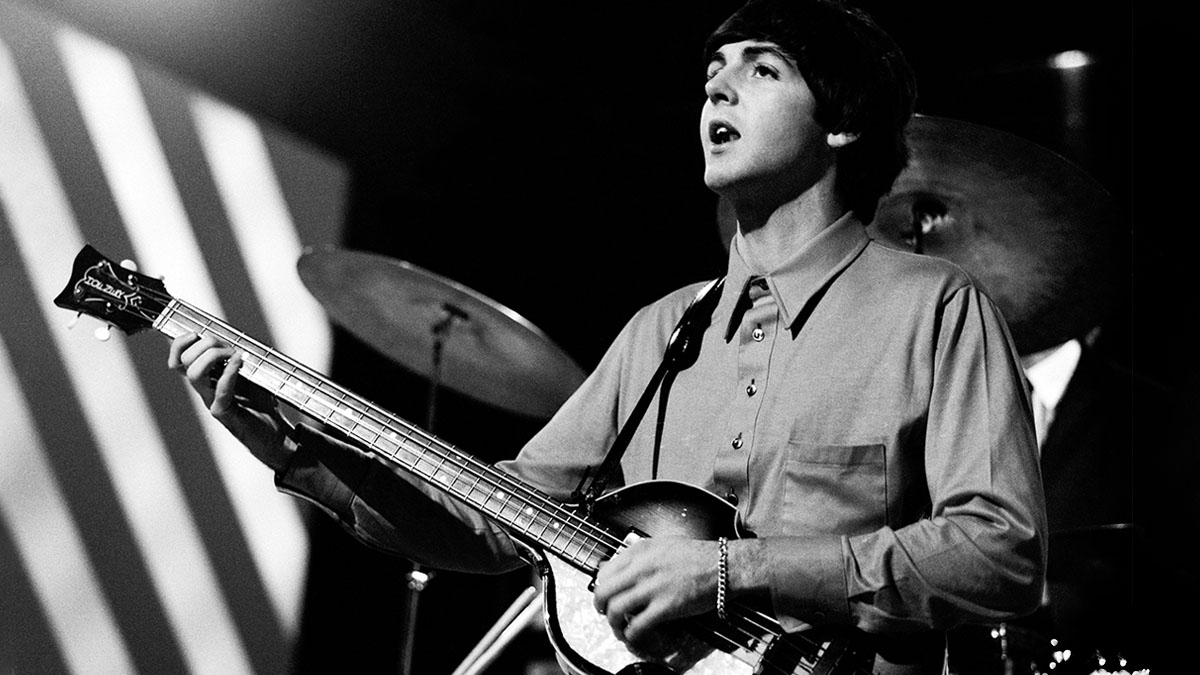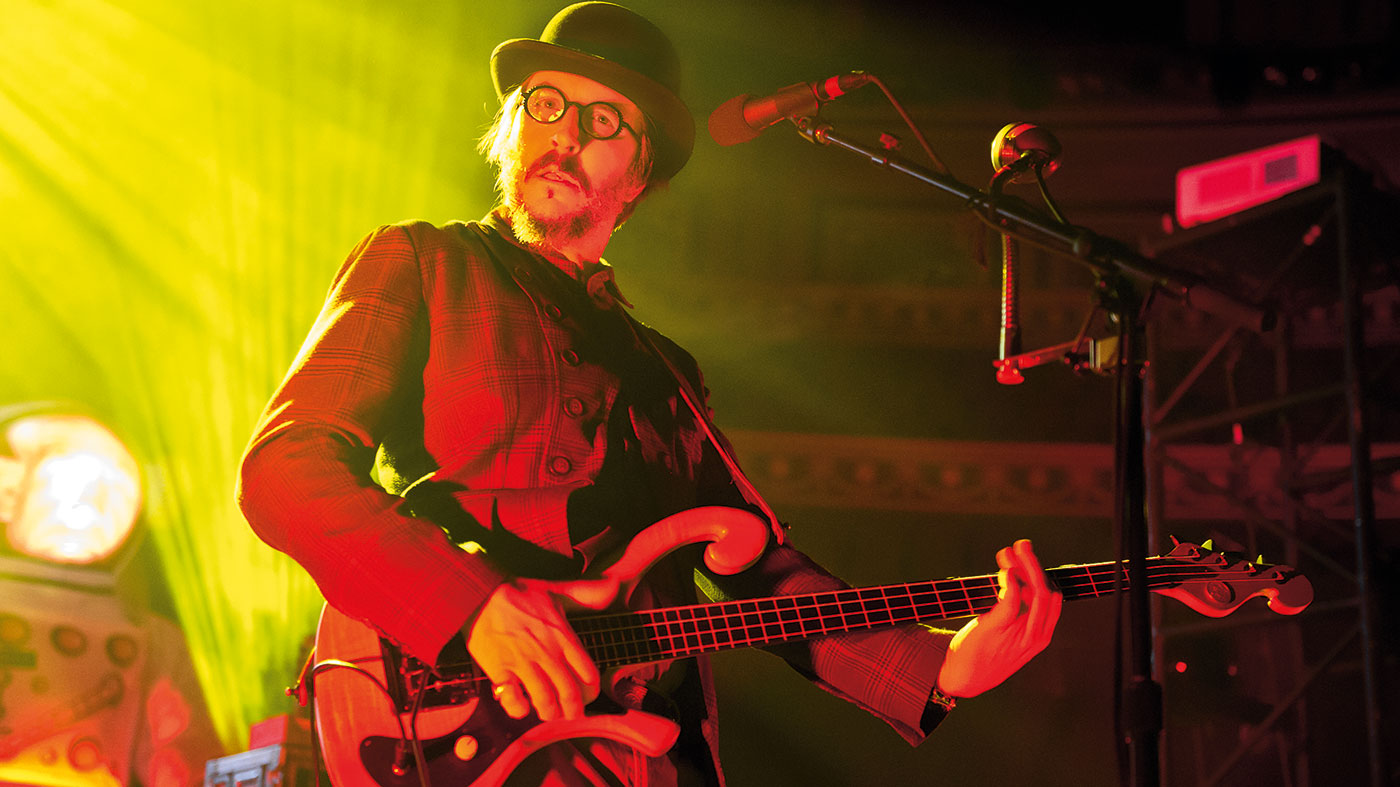Home>Instruments>Bass>Who Played The Bass In The Beatles


Bass
Who Played The Bass In The Beatles
Published: November 29, 2023
Discover who played the bass in The Beatles and contributed to their iconic sound. Explore the talented musicians who held down the low end in this legendary band.
(Many of the links in this article redirect to a specific reviewed product. Your purchase of these products through affiliate links helps to generate commission for AudioLover.com, at no extra cost. Learn more)
Table of Contents
Introduction
The Beatles, one of the most iconic and influential bands in the history of music, made a profound impact on popular culture. Their innovative songwriting, catchy melodies, and groundbreaking techniques continue to resonate with generations of music lovers. While the band consisted of four exceptionally talented musicians, including John Lennon, Paul McCartney, George Harrison, and Ringo Starr, one member’s role often goes underappreciated – the bassist.
In this article, we will delve into the intriguing story of the bassists in The Beatles. We will explore how the band’s bass sound evolved over the years, from their early days in Liverpool to their groundbreaking albums like “Revolver” and “Sgt. Pepper’s Lonely Hearts Club Band.”
From the band’s humble beginnings in the early 1960s to their meteoric rise to fame during the Beatlemania era, we will uncover the journey of the bass players who left their mark on The Beatles’ sound. We’ll also examine how their contributions influenced the development of bass playing in popular music.
Throughout their career, The Beatles experimented with various musical styles and techniques, pushing the boundaries of what was possible in popular music. This had a significant impact on the bass players’ role within the band.
Join us on this fascinating journey as we explore the bassists in The Beatles and their contribution to the band’s legendary sound.
Early Years: Stuart Sutcliffe
In the early years of The Beatles, before they achieved worldwide fame, the role of the bassist was initially filled by Stuart Sutcliffe. Sutcliffe, a close friend of John Lennon, joined the band in 1960 when they were still known as The Quarrymen.
Sutcliffe’s addition to the band was not solely based on his musical abilities, as he was primarily an artist and not an experienced bass player. Nevertheless, his cool and artistic persona added an aesthetic appeal to the band’s image.
During this period, The Beatles were primarily a rock and roll cover band, performing hits from artists like Chuck Berry and Little Richard. Sutcliffe’s simplistic bass lines helped anchor the band’s sound, providing a solid foundation along with the drums.
However, Sutcliffe’s musical journey with The Beatles was tragically cut short. In 1961, he made the difficult decision to leave the band to pursue his career as a painter. It was a heartbreaking loss for The Beatles, as Sutcliffe’s artistic presence was appreciated by both the band members and their growing fanbase.
Although his time with the band was short-lived, Sutcliffe’s influence on The Beatles cannot be understated. He played a crucial role in shaping the band’s early sound and image, and his departure marked a turning point in the band’s evolution.
While Sutcliffe’s contributions as a bassist were limited, his impact on The Beatles was immeasurable. His unique artistic sensibilities paved the way for the band’s exploration of new sounds and ideas, setting the stage for the arrival of their next bass player, who would go on to become an integral part of The Beatles’ success.
The Arrival of Paul McCartney
With the departure of Stuart Sutcliffe, The Beatles needed to find a new bassist to fill the void. Fortunately, their talented guitarist, Paul McCartney, stepped up to the challenge and took on the responsibility of playing bass for the band.
McCartney’s transition to the bass guitar was not a simple task. As a guitarist, he had to adapt to a different instrument and learn a new role within the band. However, McCartney’s exceptional musical abilities and dedication allowed him to quickly excel in his new role.
McCartney’s melodic approach to bass playing became a defining characteristic of The Beatles’ sound. He brought a unique style and creativity to the instrument, often incorporating intricate melodies and vibrant harmonies into his bass lines.
One notable example of McCartney’s bass playing prowess is evident in songs like “Rain” and “Something.” In these tracks, his basslines serve as melodic counterpoints to the vocals and guitars, showcasing his ability to elevate the rhythm section beyond the traditional role of a bassist.
Moreover, McCartney’s bass playing became an essential element in the band’s songwriting process. His innovative basslines served as foundations for many of their iconic songs, such as “With a Little Help From My Friends” and “Penny Lane.”
McCartney’s contributions extended beyond his technical skills as a bassist. He possessed a deep understanding of harmony and musical structure, which allowed him to collaborate effectively with his bandmates in crafting intricate and memorable arrangements.
In addition to his role as a bassist, McCartney’s vocal harmonies enriched The Beatles’ sound. His ability to seamlessly blend his voice with Lennon’s brought a unique depth and texture to their music. This distinctive vocal harmony became a signature element of their sound, highlighting the close bond and musical synergy between McCartney and Lennon.
Overall, McCartney’s arrival as the bassist of The Beatles brought a new level of musicality and creativity to the band. His melodic bass playing and harmonic sensibilities played a key role in shaping their distinctive sound, contributing to their incredible musical legacy.
Paul McCartney as the Primary Bassist
After stepping into the role of bassist for The Beatles, Paul McCartney emerged as the primary bass player for the band. His influence and impact on the bass guitar cannot be overstated, as his innovative approach revolutionized the instrument’s role in popular music.
McCartney’s skillful bass playing extended beyond traditional root note patterns and simple accompaniment. He embraced the instrument as a melodic and expressive tool, delivering intricate and memorable basslines that became defining elements of The Beatles’ songs.
One of McCartney’s notable bass performances is in the song “Come Together.” His inventive bassline serves as a driving force behind the song’s infectious groove and adds a distinct rhythmic complexity to the composition. This style of melodic bass playing set a new standard for future musicians and greatly influenced the evolution of bass guitar in popular music.
McCartney’s versatility as a bassist can be seen in the diverse range of musical styles explored by The Beatles. From the rock and roll roots of their early years to the psychedelic and experimental sounds of their later albums, McCartney consistently adapted his playing to suit the changing musical landscape.
Aside from his technical skills, McCartney’s deep understanding of music theory and his keen ear for harmonies allowed him to craft basslines that complemented and enhanced the songs. His ability to seamlessly blend his bass playing with the vocal melodies and guitar parts created a rich and layered sonic tapestry that set The Beatles apart from their contemporaries.
McCartney’s influence as a bass player extended beyond his time with The Beatles. His melodic approach and adventurous spirit inspired countless musicians to explore new possibilities on the bass guitar. Even today, his basslines continue to be studied, emulated, and revered by aspiring bassists worldwide.
Throughout his tenure as The Beatles’ primary bassist, McCartney not only showcased his technical prowess but also demonstrated his innate musicality. His contributions to the band’s sound were instrumental in their success, and his influence as a bass player still echoes in the world of music.
When reflecting on Paul McCartney’s role as the primary bassist of The Beatles, it becomes clear that his innovative style and musical brilliance forever transformed the perception and potential of the bass guitar.
The Infamous “Beatlemania” Era
The Beatles reached the height of their fame during the phenomenon known as “Beatlemania.” This era, which spanned from the mid-1960s, was characterized by an unprecedented level of fan frenzy and adoration for the band. The Beatles became global icons, and their energetic live performances captivated audiences worldwide.
During the “Beatlemania” era, the role of the bassist in the band took on a new significance. With the intense volume of their live shows and the overwhelming screams of adoring fans, it became challenging to hear the subtleties of individual instruments. However, the bass guitar played a crucial role in anchoring the band’s sound amidst the chaos.
Paul McCartney’s basslines served as the driving force behind many of their hit songs during this period. In tracks like “I Want to Hold Your Hand” and “She Loves You,” the melodic basslines cut through the frenzy of the screaming crowd and added a solid foundation to the band’s live performance.
Furthermore, McCartney’s bass playing became the backbone of The Beatles’ rhythm section, locking in with Ringo Starr’s drumming to create a powerful and infectious groove. This synergy between the bass and drums was essential in keeping the band tight and cohesive, even amidst the hysteria of their live shows.
Despite the limitations of live performances during the “Beatlemania” era, McCartney’s bass playing remained a crucial element of The Beatles’ sonic identity. His ability to maintain the band’s signature sound with precision and energy added to the electrifying atmosphere of their concerts.
Moreover, McCartney’s mastery of the bass guitar provided a solid foundation for the band’s musical experimentation. As The Beatles ventured into more complex and innovative songwriting styles, the basslines became integral to their compositions. McCartney’s ability to weave intricate and memorable bass melodies into their songs helped elevate their music beyond simple pop tunes.
Overall, the “Beatlemania” era showcased the indispensability of the bass guitar in The Beatles’ sound. McCartney’s skillful bass playing, combined with his stage presence and charisma, played a significant part in the band’s success during this tumultuous period. His ability to cut through the noise and deliver captivating basslines solidified his status as one of the premier bassists in rock history.
The Experimental Phase: Revolver and Beyond
As The Beatles progressed in their musical journey, their sound began to evolve into more experimental and boundary-pushing territory. The album that marked a turning point in their artistic direction was “Revolver,” released in 1966. This period of musical experimentation allowed the bass to take on an even more prominent role within the band’s compositions.
Paul McCartney’s bass playing on “Revolver” showcased his versatility as a musician and his willingness to explore new sounds. Songs like “Taxman” and “Rain” featured intricate basslines that pushed the boundaries of what was previously expected from the instrument. McCartney’s bass became a melodic and rhythmic force, adding layers of complexity and depth to the songs.
One of the standout bass performances on “Revolver” can be heard in the song “Tomorrow Never Knows.” McCartney’s hypnotic bassline, played with a distinctive fuzz tone, reinforces the droning and trippy atmosphere of the track. It exemplifies his willingness to experiment with new techniques and sonic textures.
Beyond “Revolver,” the band continued to explore new musical territories, and McCartney’s bass playing remained an integral part of their sonic exploration. In songs like “Strawberry Fields Forever” and “Lucy in the Sky with Diamonds,” McCartney’s basslines provide a solid foundation amidst the psychedelic and intricate arrangements.
McCartney’s innovative approach to the bass guitar during this period inspired other bassists to push the boundaries in their own music. His use of melodic lines, alternative tunings, and unconventional techniques widened the possibilities of what could be achieved on the instrument.
Additionally, McCartney’s role as the primary bassist allowed him to experiment further with his playing style. He explored techniques such as palm muting, double tracking, and harmonic fills, adding unique textures to the band’s compositions.
The experimental phase of The Beatles, from “Revolver” to their later works like “Sgt. Pepper’s Lonely Hearts Club Band” and “The White Album,” showcased the bass guitar as an integral component of their sonic experimentation. McCartney’s ability to adapt and innovate on the instrument contributed to the band’s groundbreaking sound and solidified his reputation as one of the most influential bassists in rock history.
Throughout this phase, McCartney’s bass lines played a vital role in creating the distinct sonic tapestry that defined their music. His willingness to push boundaries and venture into uncharted musical territory displayed his artistic growth and further cemented his legacy as a visionary bassist.
Other Members’ Contributions
While Paul McCartney took on the primary role of the bassist in The Beatles, it is important to acknowledge the contributions of the other band members in shaping the band’s sound.
John Lennon, the band’s iconic frontman and rhythm guitarist, played a significant role in the creative direction of The Beatles. While not primarily known for his bass playing, Lennon occasionally stepped in to play bass on certain tracks. His unconventional approach brought a distinct flavor to songs like “Happiness Is a Warm Gun” and “I Am the Walrus,” adding an experimental and unpredictable element to the basslines.
George Harrison, the band’s lead guitarist, also made noteworthy contributions to the bass parts in some songs, particularly during their later years. Harrison added a melodic touch to his basslines, often doubling them with his guitar playing to create a richer and harmonically intricate sound. Tracks like “Something” and “Here Comes the Sun” bear testament to Harrison’s talent as a multi-instrumentalist and his ability to bring depth to the band’s compositions.
Additionally, Ringo Starr, the band’s charismatic drummer, played a vital role in shaping the overall rhythm and groove of The Beatles’ music. While his primary instrument was the drums, Starr’s rhythmic sensibilities influenced the basslines and the entire band’s dynamic. His intuitive drumming style created a solid foundation upon which McCartney’s basslines could flourish.
Collectively, the band’s collaborative spirit and musical camaraderie allowed them to explore new territories and constantly innovate. Their willingness to experiment and push boundaries influenced the development of bass playing and the overall sound of popular music.
Furthermore, it is worth noting that the basslines in The Beatles’ songs were often a result of the collective arrangement decisions made by the band as a whole. Each member played a role in shaping the final sound, whether through suggestions, improvisations, or collaborative input.
Ultimately, the contributions of John Lennon, George Harrison, and Ringo Starr, while not as prominent as McCartney’s bass playing, were invaluable in creating the iconic sound of The Beatles. The synergy between all four members allowed for a collective creativity that propelled their music to new heights.
The Band’s Final Years and Breakup
The Beatles’ final years as a band were fraught with tension and internal conflicts, ultimately leading to their breakup in 1970. Various factors contributed to the disintegration of the group, including creative differences, personal struggles, and the overwhelming pressure of their immense success.
During this time, the role of the bassist remained crucial, as Paul McCartney continued to anchor the band’s sound with his exceptional bass playing. However, the strain within the group began to take a toll on their collaborative efforts, resulting in a decrease in cohesion and the sense of unity that had propelled them to unparalleled success.
The recording sessions for their last studio album, “Let It Be,” were particularly challenging. The band members found themselves at odds with one another, with conflicting visions for the album’s direction. Despite the discord, McCartney’s bass playing remained a driving force throughout the recordings. His solid and melodic basslines can be heard on tracks like “Let It Be” and “Get Back,” providing a reassuring backbone for the band’s final compositions.
The band’s final public performance took place on the rooftop of Apple Corps in January 1969, immortalized in the film “Let It Be.” McCartney’s basslines on that rooftop concert, such as in the iconic performance of “Don’t Let Me Down,” demonstrated his unwavering talent and commitment to his craft, even in the face of mounting tensions within the band.
Eventually, in 1970, tensions within the group came to a head, and The Beatles officially announced their break-up. Each member pursued solo careers, and while McCartney continued to release music as a solo artist, the dynamic bass playing that characterized The Beatles began to take on a new form.
The breakup of The Beatles marked the end of an era and left a void in the music industry. McCartney, as the band’s primary bassist, had helped shape their sound and had been an integral part of their success. His contributions on the bass guitar had set new standards for creativity and musicianship, influencing countless musicians to follow.
While The Beatles may have disbanded, the legacy of McCartney’s bass playing and the indelible mark he left on popular music continued to resonate. His innovative approach to the bass guitar and his role as an essential part of The Beatles’ signature sound solidified his status as an iconic and influential bassist.
The breakup of The Beatles marked the end of a remarkable musical journey, but the impact of their music, including McCartney’s bass playing, lives on, continuing to inspire and captivate audiences around the world.
Legacy: The Bassists’ Influence on Music
The influence of the bassists in The Beatles extends far beyond their time as a band, leaving an indelible mark on the world of music. The innovative approach to bass playing, spearheaded by Stuart Sutcliffe and later propelled by Paul McCartney, forever transformed the role of the bass guitar in popular music.
Stuart Sutcliffe’s early contributions laid the groundwork for the band’s exploration of different sounds and artistic expression. While his time with The Beatles was short-lived, Sutcliffe’s artistic sensibilities and his willingness to experiment influenced the band’s creative direction and set the stage for McCartney’s groundbreaking contributions.
Paul McCartney, as the primary bassist of The Beatles, redefined what could be achieved on the instrument. His melodic and inventive basslines broke free from traditional norms, elevating the bass guitar to a prominent melodic and harmonic role within the band’s compositions.
McCartney’s influence as a bass player can be felt across genres and generations. His ability to craft memorable basslines, his attention to detail, and his seamless blend of melodic and rhythmic elements has inspired countless musicians to push the boundaries of what is possible on the bass guitar.
Moreover, McCartney’s impact on the music industry extends beyond his technical prowess. His ability to connect with audiences on an emotional level through his bass playing served as a blueprint for future bassists, emphasizing the importance of not only technical skill but also the ability to evoke feeling and enhance the overall musical experience.
The innovative bass playing in The Beatles’ music influenced the development of various genres, from rock and pop to funk, soul, and beyond. Bassists around the world have adopted and adapted McCartney’s techniques, incorporating melodic lines, complex rhythms, and harmonic intricacies into their own playing.
By expanding the possibilities of the bass guitar, McCartney and his fellow bassists in The Beatles revolutionized the way the instrument is approached, elevating its status from a background instrument to a vital and integral component of a band’s sound.
The legacy of the bassists in The Beatles lives on through the countless musicians who continue to be inspired by their innovative playing. Their impact can be heard in the music of artists spanning generations, influencing how bassists approach their instrument and contribute to the overall sonic landscape of a song.
The Beatles’ bassists have left an enduring mark on the world of music, a testament to their creativity, musicality, and willingness to challenge conventions. Their contributions continue to shape the art of bass playing and will be celebrated for generations to come.











